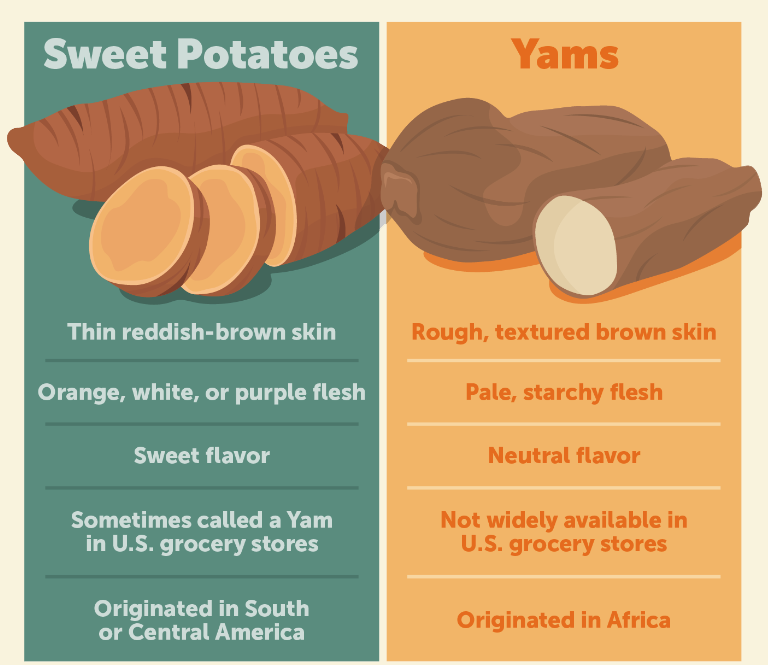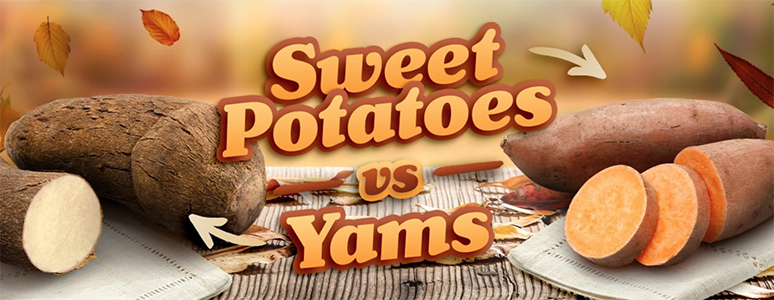||| FROM DICTIONARY.COM |||
If you’re not arguing about politics or whether or not it’s time for Grandma to get some more grandchildren, there’s one topic that’s always guaranteed to make a splash at the Thanksgiving dinner table: are those yams or sweet potatoes?
“Wait a second,” you might be saying, “aren’t they the same thing?”
Take another bite and allow us to get to the root of the difference between sweet potatoes and yams and the ways in which the two terms sometimes overlap, as well as the origins of the words—and the vegetables.
⚡Quick summary
Yams and sweet potatoes are not the same thing—they are both root vegetables, but they are different vegetables with different flavors and textures. However, sweet potatoes are sometimes referred to as yams, particularly in the US, due to a resemblance and historical associations. Things called canned yams and candied yams are usually sweet potatoes.
What is a yam?
Yams are the starchy, tuberous, edible roots of plants of the genus Dioscorea. They’re native to parts of Asia and Africa and can grow to be extremely large, with some weighing over 100 pounds! They typically have a whitish-yellowish flesh.
The word yam is ultimately derived, via Portuguese or Spanish, from a West African language called Wolof, from the word nyam, meaning “to sample” or “taste.” Similar words for yam in other African languages derive from words meaning “to eat” and “to chew.”
A true yam has rough skin and starchy flesh, usually white, purple, or tinted red. We say true yam because the name yam is sometimes used to refer to a sweet potato. More on that below.
What is a sweet potato?
The sweet potato is the sweet, starchy, edible root of the plant species Ipomoea batatas, of the morning glory family. They come in different colors, but the orange-fleshed variety is especially well-known. Sweet potatoes are native to Central and South America. They’re a popular ingredient in the US and in parts of North, Central, and South America.
Sweet potatoes aren’t in the same family as potatoes, but the word potato derives from the word batata, which means “sweet potato” in the Taíno language.

Both yams and sweet potatoes are edible roots grown for food. And the name yam is sometimes used to refer to sweet potatoes. But no, yams and sweet potatoes are not the same vegetable.
So…
What’s the difference between yams and sweet potatoes?
Yams and sweet potatoes are in fact two different vegetables. They belong to different genuses. And they’re native to different parts of the world. Yams are native to parts of Asia and Africa. And sweet potatoes are native to Central and South American and the American tropics. The confusion and association between the two vegetables in the US is rooted in the history of colonization and slavery in North America.
Sweet potatoes are believed to have been a significant source of nourishment for early European colonizers in the Americas. When African peoples were enslaved and forcibly brought to labor in North America and other places in the Americas, they identified many local ingredients with those they had known in Africa. Because the sweet potato somewhat resembled the root vegetable they were familiar with—the yam—they used that name for sweet potatoes.
Even though yams are not widely grown or available in the US, the association has continued. In some cases, sweet potatoes are even sold as yams. This is especially the case for some popular canned varieties—which are called canned yams but are actually sweet potatoes. (The US Department of Agriculture tries to help confused consumers by requiring that sweet potatoes marketed as yams be also labeled as sweet potatoes.)
That dish you call candied yams? Also (usually) sweet potatoes. Chances are, unless you’re shopping in a specialty grocery, it’s likely that the fresh vegetables you see on the shelves in the US are sweet potatoes and not yams.
**If you are reading theOrcasonian for free, thank your fellow islanders. If you would like to support theOrcasonian CLICK HERE to set your modestly-priced, voluntary subscription. Otherwise, no worries; we’re happy to share with you.**








